Leadership and Management Roles in Operations Management Context
VerifiedAdded on 2024/05/17
|20
|5144
|415
Report
AI Summary
This report provides a comprehensive analysis of the roles of leaders and managers in operations management, particularly within the context of Marks and Spencer. It differentiates between leadership and management, examining their characteristics and functions, and applies various leadership theories such as situational leadership, systems leadership, and contingency theory to different situational contexts. The report also assesses the strengths and weaknesses of these approaches within a work environment. Furthermore, it explains key approaches to operations management and the role leaders and managers play in achieving business objectives, while also assessing the factors within the business environment that impact operational management and decision-making. The report concludes by emphasizing the importance of both leadership and management in ensuring the success and sustainability of a business.
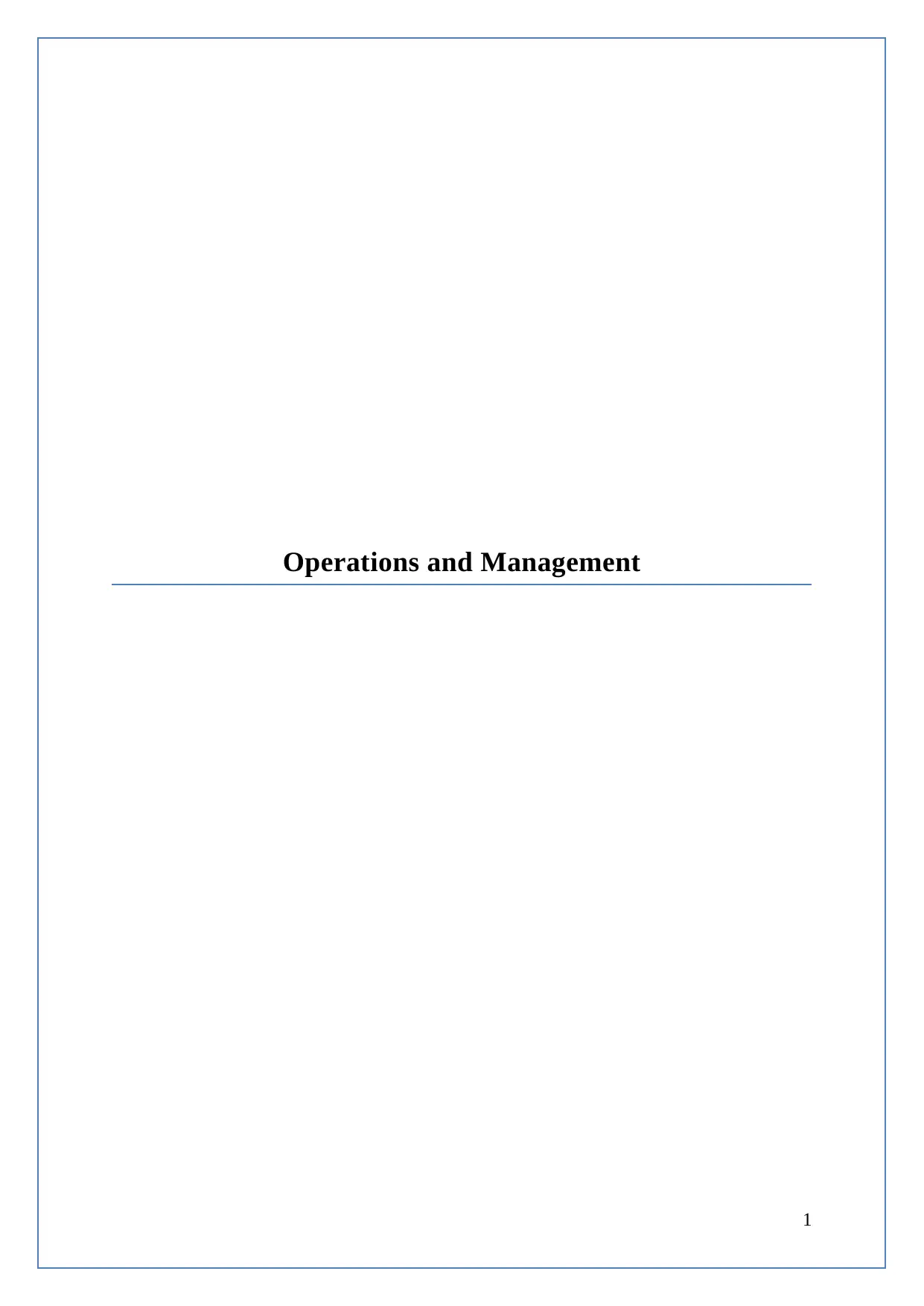
Operations and Management
1
1
Paraphrase This Document
Need a fresh take? Get an instant paraphrase of this document with our AI Paraphraser
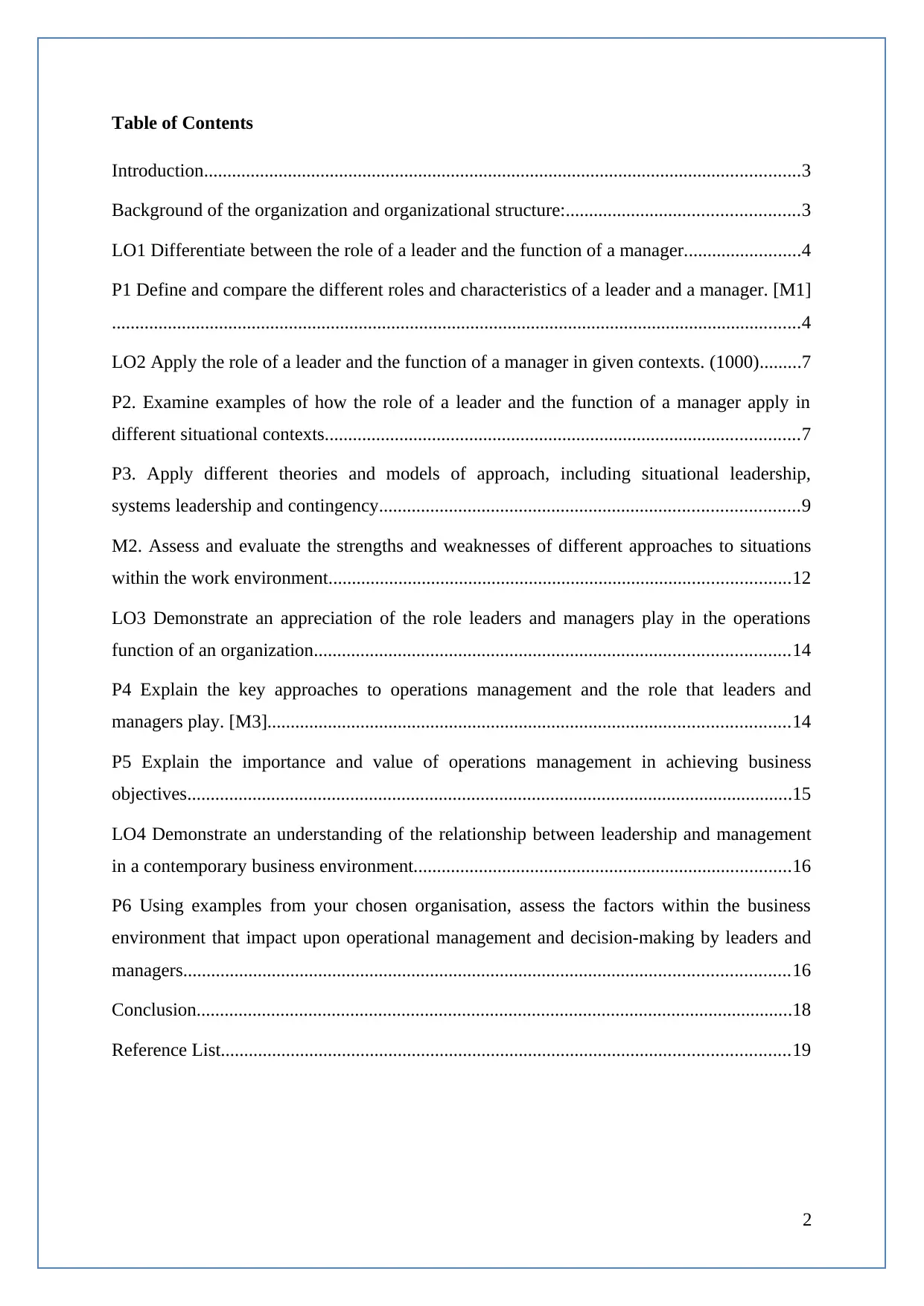
Table of Contents
Introduction................................................................................................................................3
Background of the organization and organizational structure:..................................................3
LO1 Differentiate between the role of a leader and the function of a manager.........................4
P1 Define and compare the different roles and characteristics of a leader and a manager. [M1]
....................................................................................................................................................4
LO2 Apply the role of a leader and the function of a manager in given contexts. (1000).........7
P2. Examine examples of how the role of a leader and the function of a manager apply in
different situational contexts......................................................................................................7
P3. Apply different theories and models of approach, including situational leadership,
systems leadership and contingency..........................................................................................9
M2. Assess and evaluate the strengths and weaknesses of different approaches to situations
within the work environment...................................................................................................12
LO3 Demonstrate an appreciation of the role leaders and managers play in the operations
function of an organization......................................................................................................14
P4 Explain the key approaches to operations management and the role that leaders and
managers play. [M3]................................................................................................................14
P5 Explain the importance and value of operations management in achieving business
objectives..................................................................................................................................15
LO4 Demonstrate an understanding of the relationship between leadership and management
in a contemporary business environment.................................................................................16
P6 Using examples from your chosen organisation, assess the factors within the business
environment that impact upon operational management and decision-making by leaders and
managers..................................................................................................................................16
Conclusion................................................................................................................................18
Reference List..........................................................................................................................19
2
Introduction................................................................................................................................3
Background of the organization and organizational structure:..................................................3
LO1 Differentiate between the role of a leader and the function of a manager.........................4
P1 Define and compare the different roles and characteristics of a leader and a manager. [M1]
....................................................................................................................................................4
LO2 Apply the role of a leader and the function of a manager in given contexts. (1000).........7
P2. Examine examples of how the role of a leader and the function of a manager apply in
different situational contexts......................................................................................................7
P3. Apply different theories and models of approach, including situational leadership,
systems leadership and contingency..........................................................................................9
M2. Assess and evaluate the strengths and weaknesses of different approaches to situations
within the work environment...................................................................................................12
LO3 Demonstrate an appreciation of the role leaders and managers play in the operations
function of an organization......................................................................................................14
P4 Explain the key approaches to operations management and the role that leaders and
managers play. [M3]................................................................................................................14
P5 Explain the importance and value of operations management in achieving business
objectives..................................................................................................................................15
LO4 Demonstrate an understanding of the relationship between leadership and management
in a contemporary business environment.................................................................................16
P6 Using examples from your chosen organisation, assess the factors within the business
environment that impact upon operational management and decision-making by leaders and
managers..................................................................................................................................16
Conclusion................................................................................................................................18
Reference List..........................................................................................................................19
2
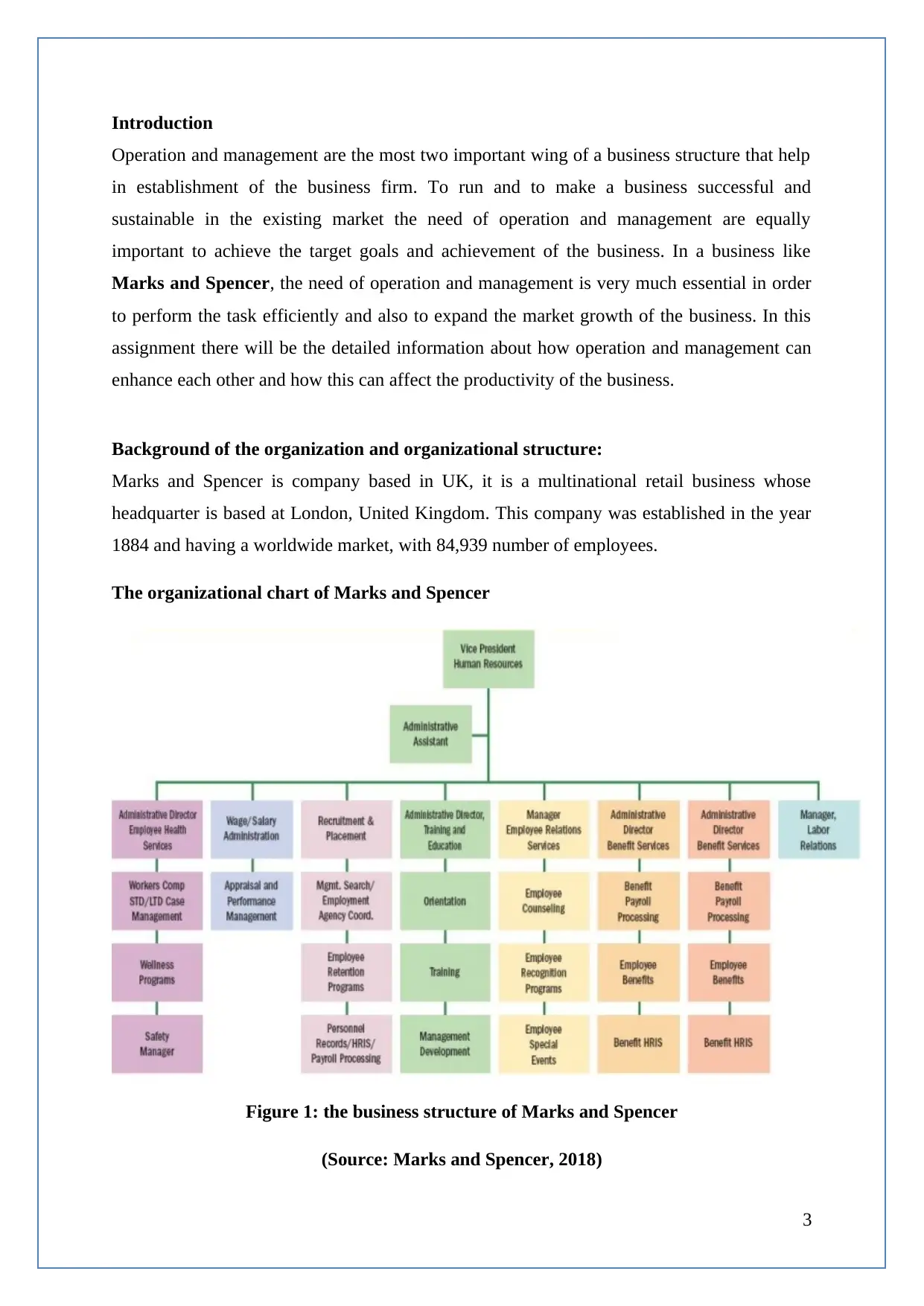
Introduction
Operation and management are the most two important wing of a business structure that help
in establishment of the business firm. To run and to make a business successful and
sustainable in the existing market the need of operation and management are equally
important to achieve the target goals and achievement of the business. In a business like
Marks and Spencer, the need of operation and management is very much essential in order
to perform the task efficiently and also to expand the market growth of the business. In this
assignment there will be the detailed information about how operation and management can
enhance each other and how this can affect the productivity of the business.
Background of the organization and organizational structure:
Marks and Spencer is company based in UK, it is a multinational retail business whose
headquarter is based at London, United Kingdom. This company was established in the year
1884 and having a worldwide market, with 84,939 number of employees.
The organizational chart of Marks and Spencer
Figure 1: the business structure of Marks and Spencer
(Source: Marks and Spencer, 2018)
3
Operation and management are the most two important wing of a business structure that help
in establishment of the business firm. To run and to make a business successful and
sustainable in the existing market the need of operation and management are equally
important to achieve the target goals and achievement of the business. In a business like
Marks and Spencer, the need of operation and management is very much essential in order
to perform the task efficiently and also to expand the market growth of the business. In this
assignment there will be the detailed information about how operation and management can
enhance each other and how this can affect the productivity of the business.
Background of the organization and organizational structure:
Marks and Spencer is company based in UK, it is a multinational retail business whose
headquarter is based at London, United Kingdom. This company was established in the year
1884 and having a worldwide market, with 84,939 number of employees.
The organizational chart of Marks and Spencer
Figure 1: the business structure of Marks and Spencer
(Source: Marks and Spencer, 2018)
3
⊘ This is a preview!⊘
Do you want full access?
Subscribe today to unlock all pages.

Trusted by 1+ million students worldwide
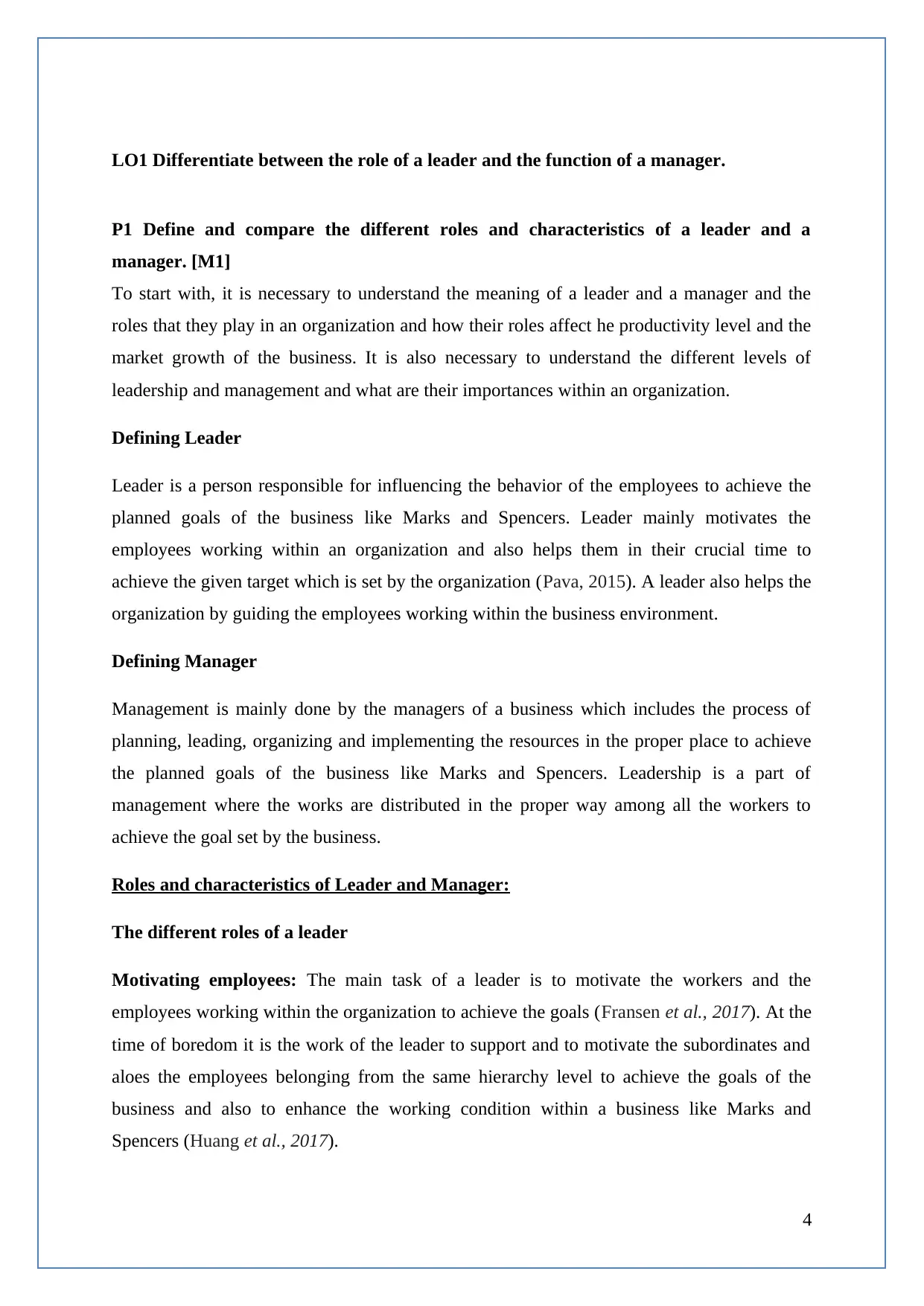
LO1 Differentiate between the role of a leader and the function of a manager.
P1 Define and compare the different roles and characteristics of a leader and a
manager. [M1]
To start with, it is necessary to understand the meaning of a leader and a manager and the
roles that they play in an organization and how their roles affect he productivity level and the
market growth of the business. It is also necessary to understand the different levels of
leadership and management and what are their importances within an organization.
Defining Leader
Leader is a person responsible for influencing the behavior of the employees to achieve the
planned goals of the business like Marks and Spencers. Leader mainly motivates the
employees working within an organization and also helps them in their crucial time to
achieve the given target which is set by the organization (Pava, 2015). A leader also helps the
organization by guiding the employees working within the business environment.
Defining Manager
Management is mainly done by the managers of a business which includes the process of
planning, leading, organizing and implementing the resources in the proper place to achieve
the planned goals of the business like Marks and Spencers. Leadership is a part of
management where the works are distributed in the proper way among all the workers to
achieve the goal set by the business.
Roles and characteristics of Leader and Manager:
The different roles of a leader
Motivating employees: The main task of a leader is to motivate the workers and the
employees working within the organization to achieve the goals (Fransen et al., 2017). At the
time of boredom it is the work of the leader to support and to motivate the subordinates and
aloes the employees belonging from the same hierarchy level to achieve the goals of the
business and also to enhance the working condition within a business like Marks and
Spencers (Huang et al., 2017).
4
P1 Define and compare the different roles and characteristics of a leader and a
manager. [M1]
To start with, it is necessary to understand the meaning of a leader and a manager and the
roles that they play in an organization and how their roles affect he productivity level and the
market growth of the business. It is also necessary to understand the different levels of
leadership and management and what are their importances within an organization.
Defining Leader
Leader is a person responsible for influencing the behavior of the employees to achieve the
planned goals of the business like Marks and Spencers. Leader mainly motivates the
employees working within an organization and also helps them in their crucial time to
achieve the given target which is set by the organization (Pava, 2015). A leader also helps the
organization by guiding the employees working within the business environment.
Defining Manager
Management is mainly done by the managers of a business which includes the process of
planning, leading, organizing and implementing the resources in the proper place to achieve
the planned goals of the business like Marks and Spencers. Leadership is a part of
management where the works are distributed in the proper way among all the workers to
achieve the goal set by the business.
Roles and characteristics of Leader and Manager:
The different roles of a leader
Motivating employees: The main task of a leader is to motivate the workers and the
employees working within the organization to achieve the goals (Fransen et al., 2017). At the
time of boredom it is the work of the leader to support and to motivate the subordinates and
aloes the employees belonging from the same hierarchy level to achieve the goals of the
business and also to enhance the working condition within a business like Marks and
Spencers (Huang et al., 2017).
4
Paraphrase This Document
Need a fresh take? Get an instant paraphrase of this document with our AI Paraphraser
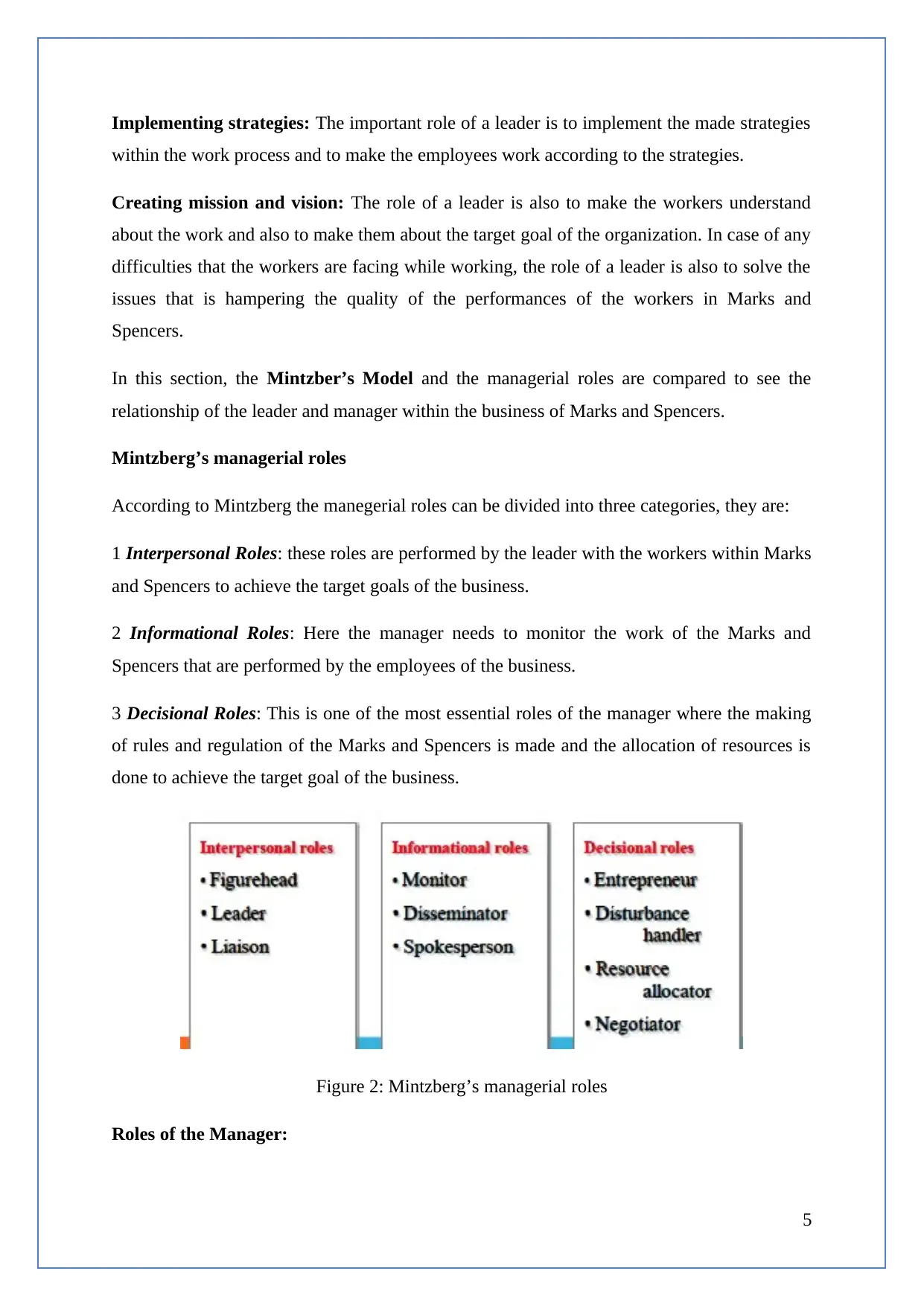
Implementing strategies: The important role of a leader is to implement the made strategies
within the work process and to make the employees work according to the strategies.
Creating mission and vision: The role of a leader is also to make the workers understand
about the work and also to make them about the target goal of the organization. In case of any
difficulties that the workers are facing while working, the role of a leader is also to solve the
issues that is hampering the quality of the performances of the workers in Marks and
Spencers.
In this section, the Mintzber’s Model and the managerial roles are compared to see the
relationship of the leader and manager within the business of Marks and Spencers.
Mintzberg’s managerial roles
According to Mintzberg the manegerial roles can be divided into three categories, they are:
1 Interpersonal Roles: these roles are performed by the leader with the workers within Marks
and Spencers to achieve the target goals of the business.
2 Informational Roles: Here the manager needs to monitor the work of the Marks and
Spencers that are performed by the employees of the business.
3 Decisional Roles: This is one of the most essential roles of the manager where the making
of rules and regulation of the Marks and Spencers is made and the allocation of resources is
done to achieve the target goal of the business.
Figure 2: Mintzberg’s managerial roles
Roles of the Manager:
5
within the work process and to make the employees work according to the strategies.
Creating mission and vision: The role of a leader is also to make the workers understand
about the work and also to make them about the target goal of the organization. In case of any
difficulties that the workers are facing while working, the role of a leader is also to solve the
issues that is hampering the quality of the performances of the workers in Marks and
Spencers.
In this section, the Mintzber’s Model and the managerial roles are compared to see the
relationship of the leader and manager within the business of Marks and Spencers.
Mintzberg’s managerial roles
According to Mintzberg the manegerial roles can be divided into three categories, they are:
1 Interpersonal Roles: these roles are performed by the leader with the workers within Marks
and Spencers to achieve the target goals of the business.
2 Informational Roles: Here the manager needs to monitor the work of the Marks and
Spencers that are performed by the employees of the business.
3 Decisional Roles: This is one of the most essential roles of the manager where the making
of rules and regulation of the Marks and Spencers is made and the allocation of resources is
done to achieve the target goal of the business.
Figure 2: Mintzberg’s managerial roles
Roles of the Manager:
5
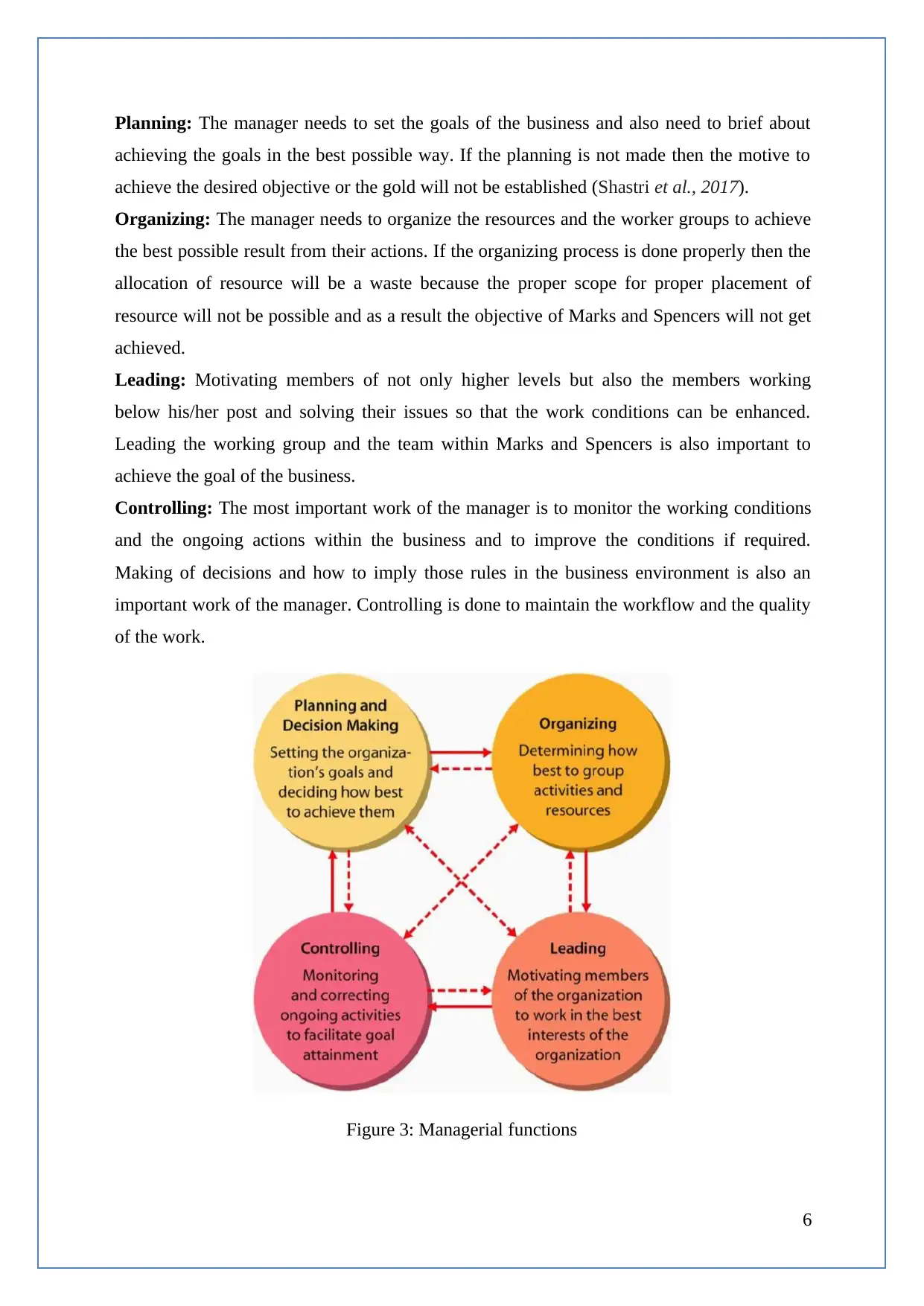
Planning: The manager needs to set the goals of the business and also need to brief about
achieving the goals in the best possible way. If the planning is not made then the motive to
achieve the desired objective or the gold will not be established (Shastri et al., 2017).
Organizing: The manager needs to organize the resources and the worker groups to achieve
the best possible result from their actions. If the organizing process is done properly then the
allocation of resource will be a waste because the proper scope for proper placement of
resource will not be possible and as a result the objective of Marks and Spencers will not get
achieved.
Leading: Motivating members of not only higher levels but also the members working
below his/her post and solving their issues so that the work conditions can be enhanced.
Leading the working group and the team within Marks and Spencers is also important to
achieve the goal of the business.
Controlling: The most important work of the manager is to monitor the working conditions
and the ongoing actions within the business and to improve the conditions if required.
Making of decisions and how to imply those rules in the business environment is also an
important work of the manager. Controlling is done to maintain the workflow and the quality
of the work.
Figure 3: Managerial functions
6
achieving the goals in the best possible way. If the planning is not made then the motive to
achieve the desired objective or the gold will not be established (Shastri et al., 2017).
Organizing: The manager needs to organize the resources and the worker groups to achieve
the best possible result from their actions. If the organizing process is done properly then the
allocation of resource will be a waste because the proper scope for proper placement of
resource will not be possible and as a result the objective of Marks and Spencers will not get
achieved.
Leading: Motivating members of not only higher levels but also the members working
below his/her post and solving their issues so that the work conditions can be enhanced.
Leading the working group and the team within Marks and Spencers is also important to
achieve the goal of the business.
Controlling: The most important work of the manager is to monitor the working conditions
and the ongoing actions within the business and to improve the conditions if required.
Making of decisions and how to imply those rules in the business environment is also an
important work of the manager. Controlling is done to maintain the workflow and the quality
of the work.
Figure 3: Managerial functions
6
⊘ This is a preview!⊘
Do you want full access?
Subscribe today to unlock all pages.

Trusted by 1+ million students worldwide
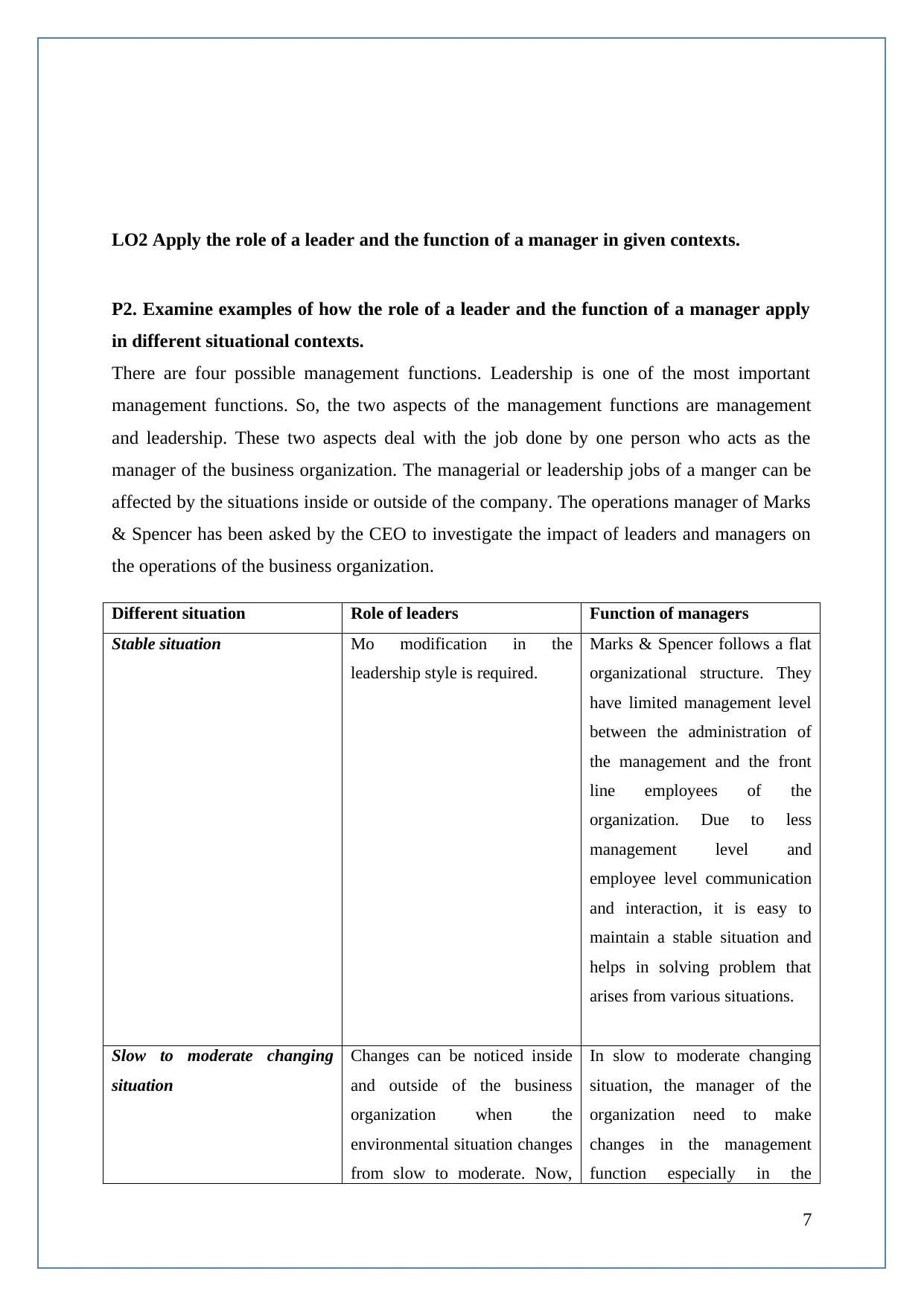
LO2 Apply the role of a leader and the function of a manager in given contexts.
P2. Examine examples of how the role of a leader and the function of a manager apply
in different situational contexts.
There are four possible management functions. Leadership is one of the most important
management functions. So, the two aspects of the management functions are management
and leadership. These two aspects deal with the job done by one person who acts as the
manager of the business organization. The managerial or leadership jobs of a manger can be
affected by the situations inside or outside of the company. The operations manager of Marks
& Spencer has been asked by the CEO to investigate the impact of leaders and managers on
the operations of the business organization.
Different situation Role of leaders Function of managers
Stable situation Mo modification in the
leadership style is required.
Marks & Spencer follows a flat
organizational structure. They
have limited management level
between the administration of
the management and the front
line employees of the
organization. Due to less
management level and
employee level communication
and interaction, it is easy to
maintain a stable situation and
helps in solving problem that
arises from various situations.
Slow to moderate changing
situation
Changes can be noticed inside
and outside of the business
organization when the
environmental situation changes
from slow to moderate. Now,
In slow to moderate changing
situation, the manager of the
organization need to make
changes in the management
function especially in the
7
P2. Examine examples of how the role of a leader and the function of a manager apply
in different situational contexts.
There are four possible management functions. Leadership is one of the most important
management functions. So, the two aspects of the management functions are management
and leadership. These two aspects deal with the job done by one person who acts as the
manager of the business organization. The managerial or leadership jobs of a manger can be
affected by the situations inside or outside of the company. The operations manager of Marks
& Spencer has been asked by the CEO to investigate the impact of leaders and managers on
the operations of the business organization.
Different situation Role of leaders Function of managers
Stable situation Mo modification in the
leadership style is required.
Marks & Spencer follows a flat
organizational structure. They
have limited management level
between the administration of
the management and the front
line employees of the
organization. Due to less
management level and
employee level communication
and interaction, it is easy to
maintain a stable situation and
helps in solving problem that
arises from various situations.
Slow to moderate changing
situation
Changes can be noticed inside
and outside of the business
organization when the
environmental situation changes
from slow to moderate. Now,
In slow to moderate changing
situation, the manager of the
organization need to make
changes in the management
function especially in the
7
Paraphrase This Document
Need a fresh take? Get an instant paraphrase of this document with our AI Paraphraser
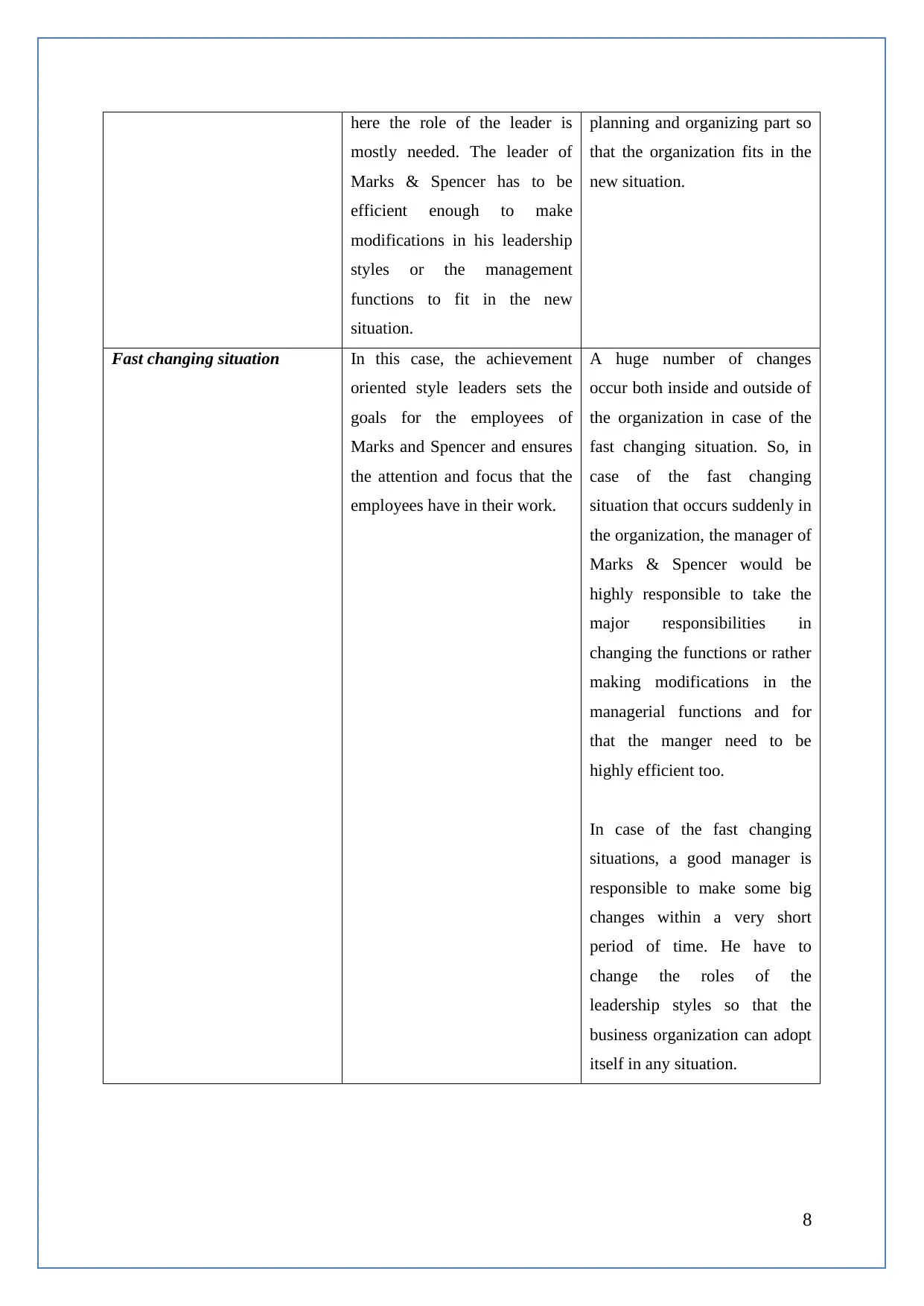
here the role of the leader is
mostly needed. The leader of
Marks & Spencer has to be
efficient enough to make
modifications in his leadership
styles or the management
functions to fit in the new
situation.
planning and organizing part so
that the organization fits in the
new situation.
Fast changing situation In this case, the achievement
oriented style leaders sets the
goals for the employees of
Marks and Spencer and ensures
the attention and focus that the
employees have in their work.
A huge number of changes
occur both inside and outside of
the organization in case of the
fast changing situation. So, in
case of the fast changing
situation that occurs suddenly in
the organization, the manager of
Marks & Spencer would be
highly responsible to take the
major responsibilities in
changing the functions or rather
making modifications in the
managerial functions and for
that the manger need to be
highly efficient too.
In case of the fast changing
situations, a good manager is
responsible to make some big
changes within a very short
period of time. He have to
change the roles of the
leadership styles so that the
business organization can adopt
itself in any situation.
8
mostly needed. The leader of
Marks & Spencer has to be
efficient enough to make
modifications in his leadership
styles or the management
functions to fit in the new
situation.
planning and organizing part so
that the organization fits in the
new situation.
Fast changing situation In this case, the achievement
oriented style leaders sets the
goals for the employees of
Marks and Spencer and ensures
the attention and focus that the
employees have in their work.
A huge number of changes
occur both inside and outside of
the organization in case of the
fast changing situation. So, in
case of the fast changing
situation that occurs suddenly in
the organization, the manager of
Marks & Spencer would be
highly responsible to take the
major responsibilities in
changing the functions or rather
making modifications in the
managerial functions and for
that the manger need to be
highly efficient too.
In case of the fast changing
situations, a good manager is
responsible to make some big
changes within a very short
period of time. He have to
change the roles of the
leadership styles so that the
business organization can adopt
itself in any situation.
8
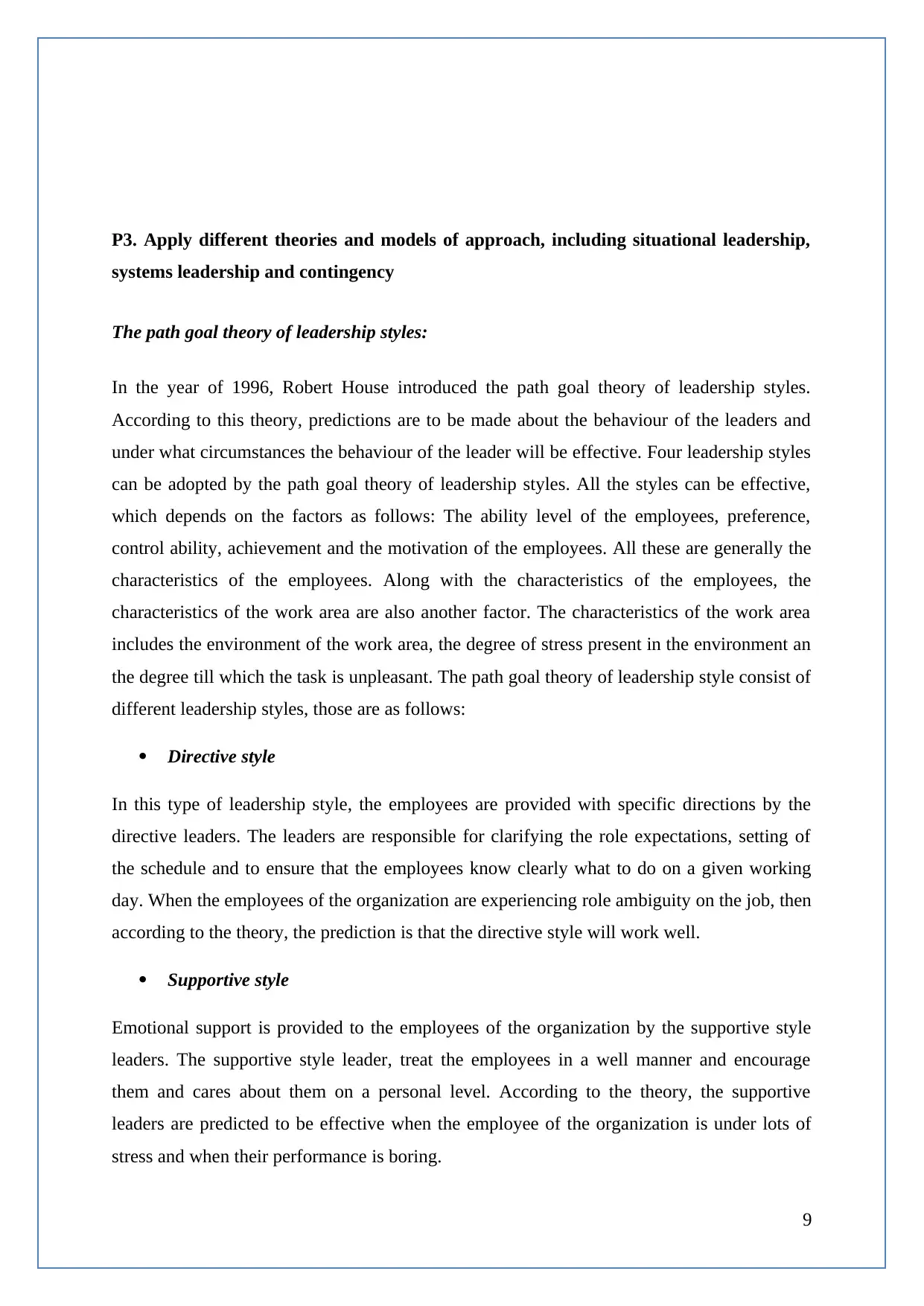
P3. Apply different theories and models of approach, including situational leadership,
systems leadership and contingency
The path goal theory of leadership styles:
In the year of 1996, Robert House introduced the path goal theory of leadership styles.
According to this theory, predictions are to be made about the behaviour of the leaders and
under what circumstances the behaviour of the leader will be effective. Four leadership styles
can be adopted by the path goal theory of leadership styles. All the styles can be effective,
which depends on the factors as follows: The ability level of the employees, preference,
control ability, achievement and the motivation of the employees. All these are generally the
characteristics of the employees. Along with the characteristics of the employees, the
characteristics of the work area are also another factor. The characteristics of the work area
includes the environment of the work area, the degree of stress present in the environment an
the degree till which the task is unpleasant. The path goal theory of leadership style consist of
different leadership styles, those are as follows:
Directive style
In this type of leadership style, the employees are provided with specific directions by the
directive leaders. The leaders are responsible for clarifying the role expectations, setting of
the schedule and to ensure that the employees know clearly what to do on a given working
day. When the employees of the organization are experiencing role ambiguity on the job, then
according to the theory, the prediction is that the directive style will work well.
Supportive style
Emotional support is provided to the employees of the organization by the supportive style
leaders. The supportive style leader, treat the employees in a well manner and encourage
them and cares about them on a personal level. According to the theory, the supportive
leaders are predicted to be effective when the employee of the organization is under lots of
stress and when their performance is boring.
9
systems leadership and contingency
The path goal theory of leadership styles:
In the year of 1996, Robert House introduced the path goal theory of leadership styles.
According to this theory, predictions are to be made about the behaviour of the leaders and
under what circumstances the behaviour of the leader will be effective. Four leadership styles
can be adopted by the path goal theory of leadership styles. All the styles can be effective,
which depends on the factors as follows: The ability level of the employees, preference,
control ability, achievement and the motivation of the employees. All these are generally the
characteristics of the employees. Along with the characteristics of the employees, the
characteristics of the work area are also another factor. The characteristics of the work area
includes the environment of the work area, the degree of stress present in the environment an
the degree till which the task is unpleasant. The path goal theory of leadership style consist of
different leadership styles, those are as follows:
Directive style
In this type of leadership style, the employees are provided with specific directions by the
directive leaders. The leaders are responsible for clarifying the role expectations, setting of
the schedule and to ensure that the employees know clearly what to do on a given working
day. When the employees of the organization are experiencing role ambiguity on the job, then
according to the theory, the prediction is that the directive style will work well.
Supportive style
Emotional support is provided to the employees of the organization by the supportive style
leaders. The supportive style leader, treat the employees in a well manner and encourage
them and cares about them on a personal level. According to the theory, the supportive
leaders are predicted to be effective when the employee of the organization is under lots of
stress and when their performance is boring.
9
⊘ This is a preview!⊘
Do you want full access?
Subscribe today to unlock all pages.

Trusted by 1+ million students worldwide
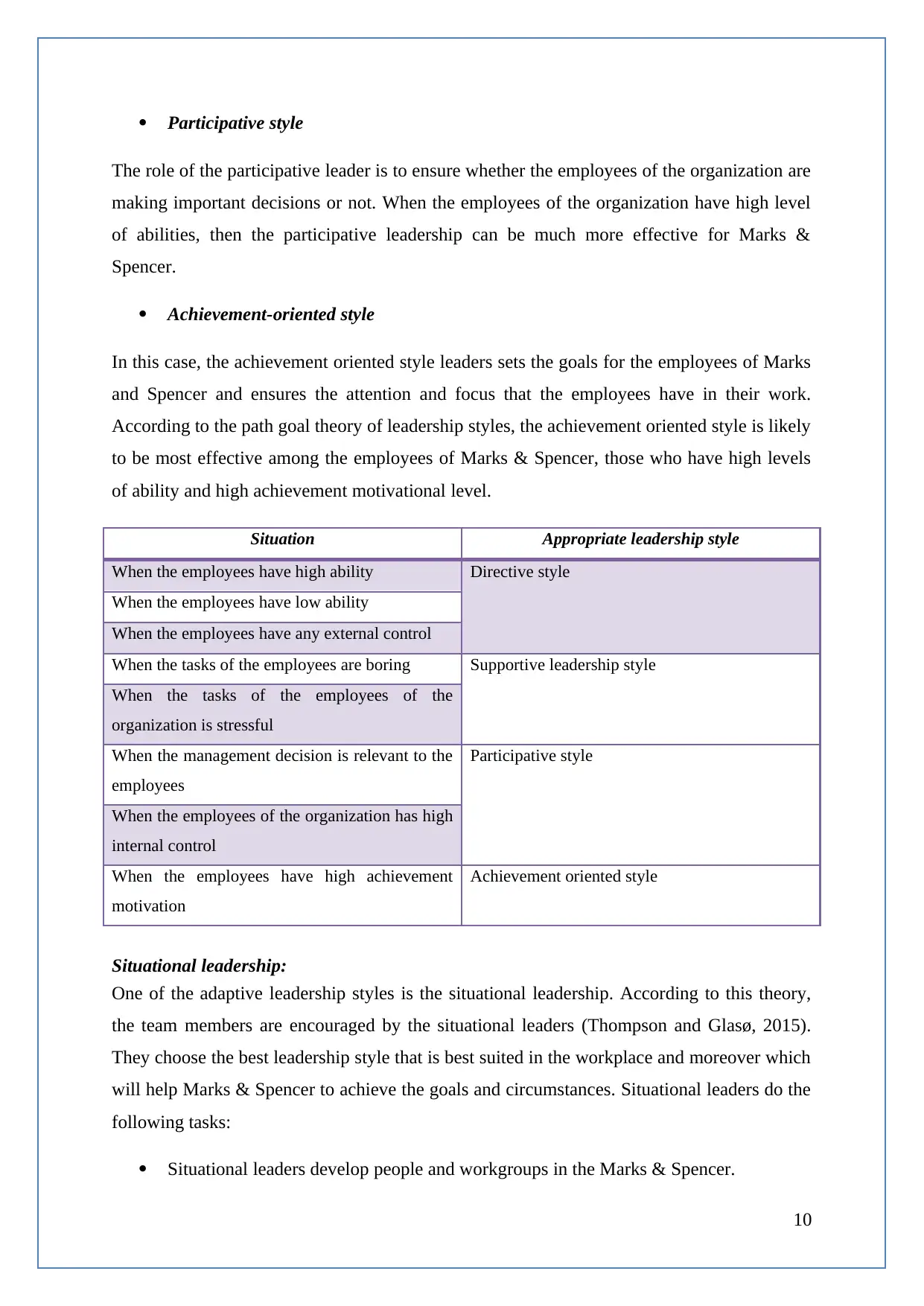
Participative style
The role of the participative leader is to ensure whether the employees of the organization are
making important decisions or not. When the employees of the organization have high level
of abilities, then the participative leadership can be much more effective for Marks &
Spencer.
Achievement-oriented style
In this case, the achievement oriented style leaders sets the goals for the employees of Marks
and Spencer and ensures the attention and focus that the employees have in their work.
According to the path goal theory of leadership styles, the achievement oriented style is likely
to be most effective among the employees of Marks & Spencer, those who have high levels
of ability and high achievement motivational level.
Situation Appropriate leadership style
When the employees have high ability Directive style
When the employees have low ability
When the employees have any external control
When the tasks of the employees are boring Supportive leadership style
When the tasks of the employees of the
organization is stressful
When the management decision is relevant to the
employees
Participative style
When the employees of the organization has high
internal control
When the employees have high achievement
motivation
Achievement oriented style
Situational leadership:
One of the adaptive leadership styles is the situational leadership. According to this theory,
the team members are encouraged by the situational leaders (Thompson and Glasø, 2015).
They choose the best leadership style that is best suited in the workplace and moreover which
will help Marks & Spencer to achieve the goals and circumstances. Situational leaders do the
following tasks:
Situational leaders develop people and workgroups in the Marks & Spencer.
10
The role of the participative leader is to ensure whether the employees of the organization are
making important decisions or not. When the employees of the organization have high level
of abilities, then the participative leadership can be much more effective for Marks &
Spencer.
Achievement-oriented style
In this case, the achievement oriented style leaders sets the goals for the employees of Marks
and Spencer and ensures the attention and focus that the employees have in their work.
According to the path goal theory of leadership styles, the achievement oriented style is likely
to be most effective among the employees of Marks & Spencer, those who have high levels
of ability and high achievement motivational level.
Situation Appropriate leadership style
When the employees have high ability Directive style
When the employees have low ability
When the employees have any external control
When the tasks of the employees are boring Supportive leadership style
When the tasks of the employees of the
organization is stressful
When the management decision is relevant to the
employees
Participative style
When the employees of the organization has high
internal control
When the employees have high achievement
motivation
Achievement oriented style
Situational leadership:
One of the adaptive leadership styles is the situational leadership. According to this theory,
the team members are encouraged by the situational leaders (Thompson and Glasø, 2015).
They choose the best leadership style that is best suited in the workplace and moreover which
will help Marks & Spencer to achieve the goals and circumstances. Situational leaders do the
following tasks:
Situational leaders develop people and workgroups in the Marks & Spencer.
10
Paraphrase This Document
Need a fresh take? Get an instant paraphrase of this document with our AI Paraphraser
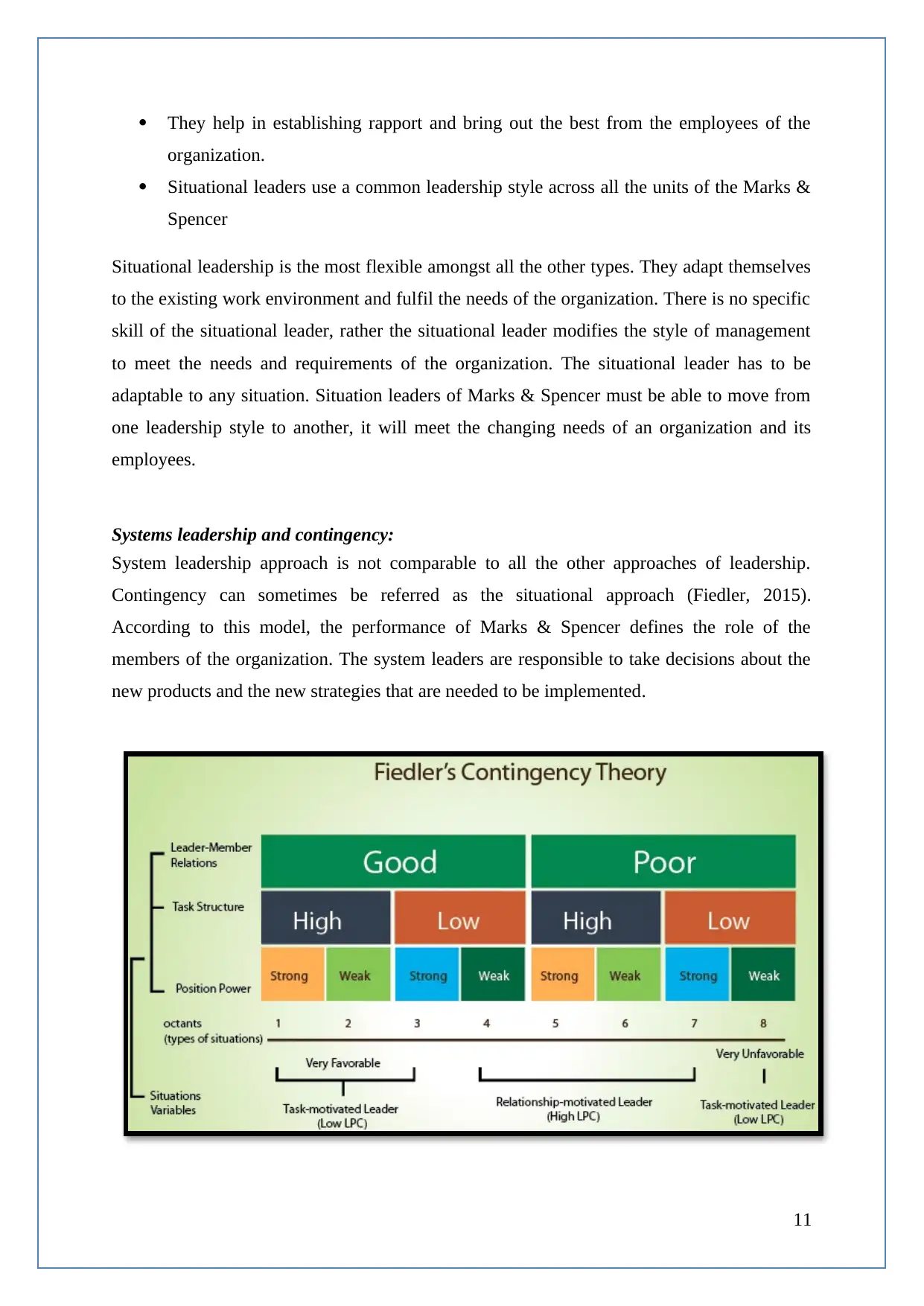
They help in establishing rapport and bring out the best from the employees of the
organization.
Situational leaders use a common leadership style across all the units of the Marks &
Spencer
Situational leadership is the most flexible amongst all the other types. They adapt themselves
to the existing work environment and fulfil the needs of the organization. There is no specific
skill of the situational leader, rather the situational leader modifies the style of management
to meet the needs and requirements of the organization. The situational leader has to be
adaptable to any situation. Situation leaders of Marks & Spencer must be able to move from
one leadership style to another, it will meet the changing needs of an organization and its
employees.
Systems leadership and contingency:
System leadership approach is not comparable to all the other approaches of leadership.
Contingency can sometimes be referred as the situational approach (Fiedler, 2015).
According to this model, the performance of Marks & Spencer defines the role of the
members of the organization. The system leaders are responsible to take decisions about the
new products and the new strategies that are needed to be implemented.
11
organization.
Situational leaders use a common leadership style across all the units of the Marks &
Spencer
Situational leadership is the most flexible amongst all the other types. They adapt themselves
to the existing work environment and fulfil the needs of the organization. There is no specific
skill of the situational leader, rather the situational leader modifies the style of management
to meet the needs and requirements of the organization. The situational leader has to be
adaptable to any situation. Situation leaders of Marks & Spencer must be able to move from
one leadership style to another, it will meet the changing needs of an organization and its
employees.
Systems leadership and contingency:
System leadership approach is not comparable to all the other approaches of leadership.
Contingency can sometimes be referred as the situational approach (Fiedler, 2015).
According to this model, the performance of Marks & Spencer defines the role of the
members of the organization. The system leaders are responsible to take decisions about the
new products and the new strategies that are needed to be implemented.
11
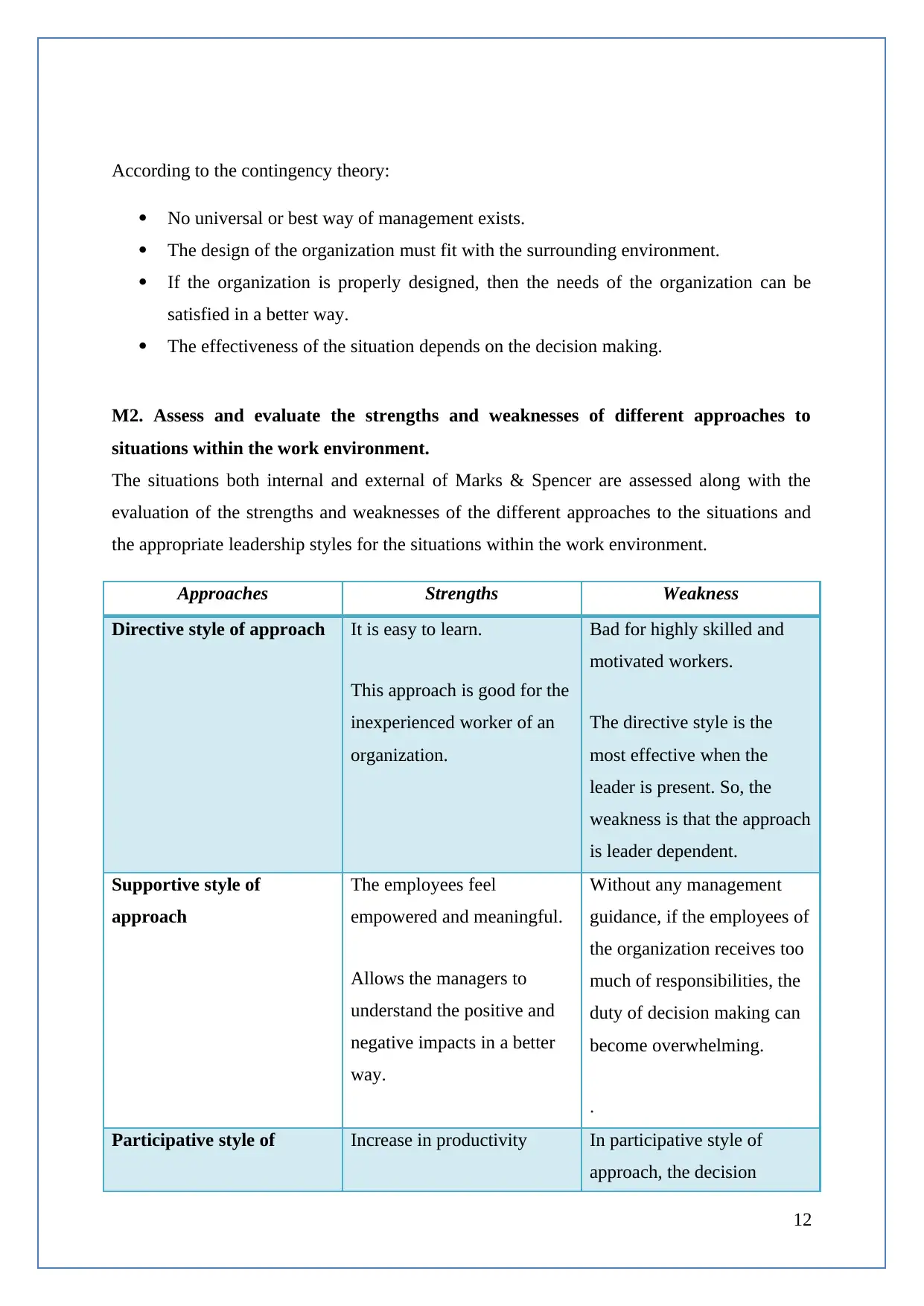
According to the contingency theory:
No universal or best way of management exists.
The design of the organization must fit with the surrounding environment.
If the organization is properly designed, then the needs of the organization can be
satisfied in a better way.
The effectiveness of the situation depends on the decision making.
M2. Assess and evaluate the strengths and weaknesses of different approaches to
situations within the work environment.
The situations both internal and external of Marks & Spencer are assessed along with the
evaluation of the strengths and weaknesses of the different approaches to the situations and
the appropriate leadership styles for the situations within the work environment.
Approaches Strengths Weakness
Directive style of approach It is easy to learn.
This approach is good for the
inexperienced worker of an
organization.
Bad for highly skilled and
motivated workers.
The directive style is the
most effective when the
leader is present. So, the
weakness is that the approach
is leader dependent.
Supportive style of
approach
The employees feel
empowered and meaningful.
Allows the managers to
understand the positive and
negative impacts in a better
way.
Without any management
guidance, if the employees of
the organization receives too
much of responsibilities, the
duty of decision making can
become overwhelming.
.
Participative style of Increase in productivity In participative style of
approach, the decision
12
No universal or best way of management exists.
The design of the organization must fit with the surrounding environment.
If the organization is properly designed, then the needs of the organization can be
satisfied in a better way.
The effectiveness of the situation depends on the decision making.
M2. Assess and evaluate the strengths and weaknesses of different approaches to
situations within the work environment.
The situations both internal and external of Marks & Spencer are assessed along with the
evaluation of the strengths and weaknesses of the different approaches to the situations and
the appropriate leadership styles for the situations within the work environment.
Approaches Strengths Weakness
Directive style of approach It is easy to learn.
This approach is good for the
inexperienced worker of an
organization.
Bad for highly skilled and
motivated workers.
The directive style is the
most effective when the
leader is present. So, the
weakness is that the approach
is leader dependent.
Supportive style of
approach
The employees feel
empowered and meaningful.
Allows the managers to
understand the positive and
negative impacts in a better
way.
Without any management
guidance, if the employees of
the organization receives too
much of responsibilities, the
duty of decision making can
become overwhelming.
.
Participative style of Increase in productivity In participative style of
approach, the decision
12
⊘ This is a preview!⊘
Do you want full access?
Subscribe today to unlock all pages.

Trusted by 1+ million students worldwide
1 out of 20
Related Documents
Your All-in-One AI-Powered Toolkit for Academic Success.
+13062052269
info@desklib.com
Available 24*7 on WhatsApp / Email
![[object Object]](/_next/static/media/star-bottom.7253800d.svg)
Unlock your academic potential
Copyright © 2020–2025 A2Z Services. All Rights Reserved. Developed and managed by ZUCOL.





